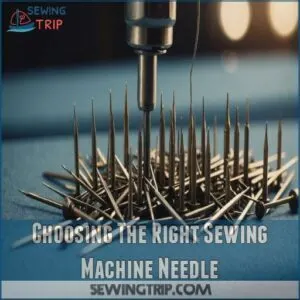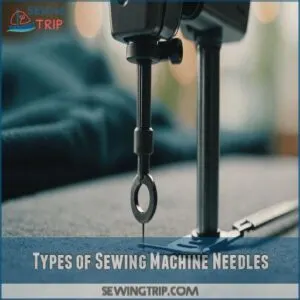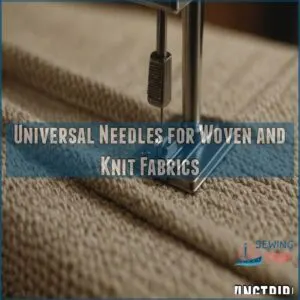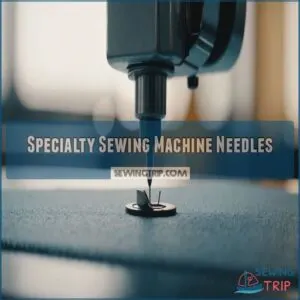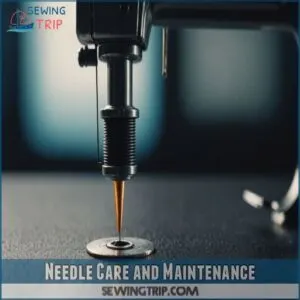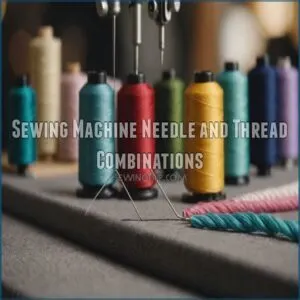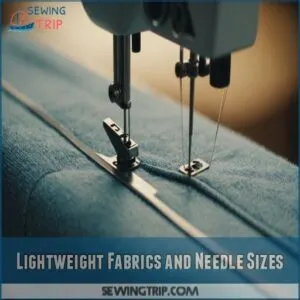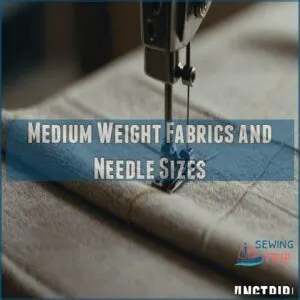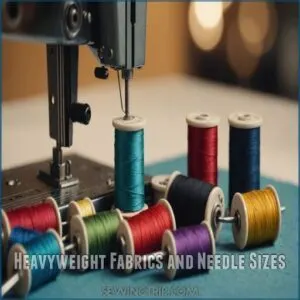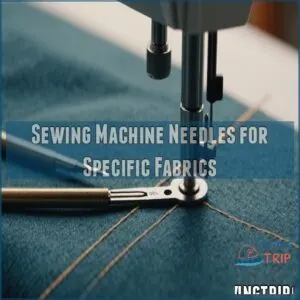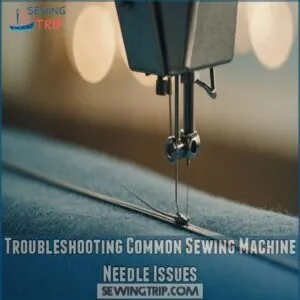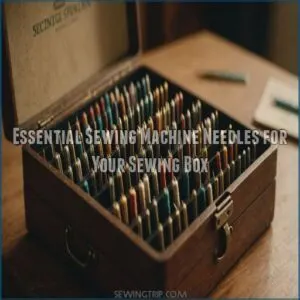This site is supported by our readers. We may earn a commission, at no cost to you, if you purchase through links.
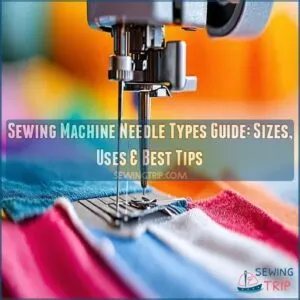
Different fabrics need different needles; using the wrong one leads to broken needles and frustrating results.
For knits, you need ballpoint needles; denim requires a denim needle.
A universal needle works for many woven fabrics, but don’t forget specialty needles for leather or metallic threads.
Understanding needle sizes and their relation to thread weight is essential for achieving professional-looking stitches.
This is just the beginning; discover how to choose the perfect needle-thread combination for flawless results.
Table Of Contents
- Key Takeaways
- Choosing The Right Sewing Machine Needle
- Types of Sewing Machine Needles
- Universal Needles for Woven and Knit Fabrics
- Specialty Sewing Machine Needles
- Needle Care and Maintenance
- Sewing Machine Needle and Thread Combinations
- Sewing Machine Needle Size Guide
- Sewing Machine Needles for Specific Fabrics
- Troubleshooting Common Sewing Machine Needle Issues
- Essential Sewing Machine Needles for Your Sewing Box
- Frequently Asked Questions (FAQs)
- Conclusion
Key Takeaways
- Select the right needle type based on your fabric; ballpoint needles for knits, denim needles for tough materials, and universal needles for most woven fabrics.
- Match needle size to fabric weight: thin needles for light fabrics, thicker needles for heavy materials.
- Pair thread weight with needle size to ensure smooth stitching and prevent thread breakage.
- Use color-coded needles for easy identification and always replace dull or damaged needles to maintain stitch quality.
Choosing The Right Sewing Machine Needle
Picking the right sewing machine needle is essential for beautiful stitches and happy fabric.
Consider your fabric’s weight and the thread you’re using—a heavier fabric needs a sturdier needle, and the wrong needle can lead to broken threads or damaged material.
Fabric Weight and Needle Size
When you’re picking a needle for your sewing project, matching needle size to fabric weight is essential. A thicker needle suits heavier fabrics, while finer needles work with lighter ones.
Consider these key points:
- Use a needle size chart
- Check fabric thickness
- Match needle selection with fabric types
- Choose the right sewing needle sizes
- Refer to a sewing machine needle chart
Thread Weight and Type
Choosing the right sewing machine needle involves understanding thread weight and type.
Picture a thread weight chart guiding you through sewing thread types—considering factors like thread selection and tension is crucial for preventing issues like looping threads and bobbin case problems—the perfect thread properties lead to balanced thread tension.
When choosing thread, match thread weight with needle size to avoid mishaps.
Different needle types accommodate diverse sewing machine needles, ensuring smooth stitching without the drama.
Needle Size Chart
Thread weight got you confused? Enter the world of the needle size chart!
Understanding needle size conversion helps you pick the perfect fit for your fabric.
A robust fabric weight chart aligns needle sizes to fabric demands.
With brands like Singer and Janome, needle color codes simplify needle selection, ensuring your sewing ventures go off without a hitch.
Types of Sewing Machine Needles
Wrapping your head around sewing machine needle types can feel like you’re threading a needle in the dark.
But once you get the hang of it, you’ll stitch with ease.
Needles aren’t all the same; they’re divided into various types, each designed for specific fabrics and purposes.
You’ll encounter universal needles that handle most tasks, ballpoint needles for slipping through knit fabrics, and sharp needles for slicing cleanly through dense fabrics.
Specialty needles like metallic and embroidery may come in handy for decorative work.
A solid needle size chart helps here, and don’t forget needle color coding for quick identification.
With these in your sewing toolkit, you’ll sew like a pro in no time, ensuring each fabric gets the perfect match.
Universal Needles for Woven and Knit Fabrics
Universal needles are your go-to choice for tackling both woven and knit fabrics because they offer a perfect balance with their slightly rounded tip.
They’re designed to glide through a variety of materials, making them an essential addition to your sewing kit.
Features and Benefits
Universal needles, known for their needle durability, adapt to both woven and knit fabrics.
Their slightly rounded tip improves stitch quality and fabric compatibility, effortlessly gliding through material without snagging.
For best results, consider purchasing high-quality needles from a reliable source like Machine Needles Products.
With universal needles, you don’t have to change needles frequently, saving time and enhancing sewing speed.
They suit various needle sizes for seamless thread compatibility, making them a reliable choice for versatile sewing projects.
Suitable Threads and Fabrics
So, you’ve got your versatile universal needles – awesome! Now, let’s talk thread and fabric pairings. The right combination makes all the difference.
Consider these factors:
- Fabric weight: Heavier fabrics need stronger threads.
- Thread type: All-purpose thread works well for most projects.
- Needle size: Match the needle to your thread and fabric.
- Stitch length: Adjust for fabric type and desired look.
- Seam finish: Think about how you’ll finish your seams.
Choosing the right sewing machine needle for your project, such as a universal sewing machine needle, is crucial for achieving the desired results. Using the correct sewing thread and needle sizes helps you achieve a professional finish.
Recommended Needle Sizes
Choosing the right needle size can feel like solving a puzzle, but it doesn’t have to be overwhelming.
For woven fabrics, start with these size picks:
| Fabric Type | Needle Size | Use Case |
|---|---|---|
| Light Woven | 70/10 | Shirts |
| Medium Woven | 80/12 | Trousers |
| Heavy Woven | 90/14 | Curtains |
This needle size chart is your fabric weight guide and sewing machine needle guide – aim for smooth, snag-free sewing!
Specialty Sewing Machine Needles
When you’re tackling specific sewing projects, reaching for the right specialty needle can make all the difference.
Whether you’re sewing stretchy fabrics, tough denim, or delicate knits, these specialty needles are designed to handle the unique challenges each fabric presents.
Ball Point Needles for Knit Fabrics
Working with knit fabrics? Ball point needles are your secret weapon. They’ll glide between fibers, preserving the fabric’s integrity.
Here’s a quick guide:
- Choose the right size: Smaller sizes for lightweight knits, larger for thicker fabrics.
- Improve stitch quality: Prevent skipped stitches.
- Check needle tips: Smooth, rounded tips for best results.
- Troubleshoot problems: Experiment if issues persist.
Master the art with these tips!
Stretch Needles for Elastic Fabrics
Every sewist needs stretch needles in their arsenal for taming elastic fabrics like a pro.
Designed to glide through knit fabric types without causing harm, they prevent those pesky skipped stitches.
To choose the right stretch needle, consider the sewing machine needles explained for your specific fabric type.
With sizes carefully crafted for specific needs, these needles make seam run-back a thing of the past, making your sewing techniques smooth and efficient.
Grab your sewing machine needles and stitch away!
Denim and Jeans Needles
When tackling thick, tough fabrics like denim, denim needles are your best bet.
These specialty sewing machine needles have a robust, sharp tip designed for easy penetration.
Denim needle sizes range from 90/14 to 110/18, perfect for sewing with denim and topstitch needles.
Brands vary, so explore jeans needle brands that fit your project needs.
Keep your denim needles sharp for crisp stitches.
Needle Care and Maintenance
Taking good care of your sewing machine needles can extend their lifespan and guarantee your projects go smoothly.
Always store them properly, watch for signs of dullness or damage, and clean them regularly for the best results.
Proper Storage and Handling
So, you’ve mastered specialty needles? Fantastic! Now, let’s talk needle care. Proper needle storage is key.
Think of your needles as tiny, sharp superheroes; they deserve respect.
When traveling with your sewing needles, make sure to securely store them in a protective case to avoid accidental pricks, and check the TSA Rules for Sewing Needles.
Store them in a designated container, away from moisture.
Organize them by size and type for easy access.
Handle them gently, avoiding drops or rough treatment. This prevents bending or damage.
You’ll extend their lifespan and improve your sewing experience.
Signs of a Dull or Damaged Needle
Storing your needles right is just the beginning.
Watch for signs like fabric tears and thread breakage; these hint at a dull needle.
If stitches skip or a popping sound echoes, it’s time for a change.
Here’s a quick check:
| Indicator | Possible Cause | Solution |
|---|---|---|
| Fabric tears | Dull needle | Replace needle |
| Uneven stitches | Bent needle | Check and replace |
| Skipped stitches | Wrong needle size | Choose correct size |
Stay sharp with your sewing machine needles!
Cleaning and Inspecting Needles
After spotting signs of wear, give your needles the TLC they deserve with these needle hygiene tips.
Start by cleaning tools handy:
- Soft cloth for gentle wiping.
- Magnifying glass for detailed inspection steps.
- Alcohol wipes to remove residue.
- Spare pack of Schmetz needles for replacements.
Regularly changing your sewing machine needle after 6 hours of sewing or at the project’s conclusion, as recommended in guidelines for needle maintenance, helps prevent needle damage and maintain optimal performance. Regular needle maintenance helps your sewing machine run smoothly.
Sewing Machine Needle and Thread Combinations
When sewing, matching your thread and needle size is essential to create strong, smooth stitches without frequent breakage.
Understanding the importance of thread strength, elasticity, and abrasion resistance can make a significant difference in your sewing projects, leading to excellent performance and lasting seams.
Thread Strength and Needle Size
Switching needles regularly helps achieve top stitch quality, and one key aspect is matching thread strength with needle size.
Using the right needle gauge, suited to your thread weight, prevents thread breakage and fabric damage.
Select appropriate sewing needles and thread combinations; it makes a big difference.
Proper sewing machine needle sizes enhance performance and protect your project.
Thread Elasticity and Abrasion Resistance
To nail perfect seams, focus on thread elasticity and abrasion resistance.
Choose threads that match your fabric’s demands.
Here’s what to watch for:
- Thread types: Pick based on fabric tension.
- Seam durability: Make sure it lasts.
- Thread longevity: Opt for long-lasting.
- Stitch quality: Adjust needle size for denim or leather needles.
Keep these in mind, and stitch with confidence!
Matching Thread and Needle for Optimal Performance
As you consider thread elasticity and abrasion resistance, it’s time to match your thread and needle for the best sewing outcomes.
For top performance, pair thread thickness with the correct needle size based on the fabric type you’re working with.
This guarantees stitch quality and seam durability.
Whether you’re using metallic needles or quilting needles, balancing the duo is key.
Sewing Machine Needle Size Guide
Choosing the right sewing machine needle size is essential for beautiful stitches and happy fabric. Ensuring proper tension settings and avoiding issues like why my sewing machine sew zig zags is also crucial for achieving the desired results.
This guide will help you match needle sizes to different fabric weights, from delicate chiffon to sturdy denim, ensuring your projects turn out perfectly.
Lightweight Fabrics and Needle Sizes
Ever struggle with sewing lightweight fabrics like gauze or chiffon?
The trick lies in selecting the right needle.
Opt for sizes 65/9 to 75/11.
These finer needles prevent unsightly holes and puckers.
Pair them with lightweight threads to perfectly stitch delicate silk or synthetic fabrics.
To choose the right needle for your project, consider the type of fabric and thread you’re using, as well as the level of detail required, and refer to a resource like Machine Embroidery Needles for guidance. Always consult a Needle Chart for accurate needle sizes, ensuring machine embroidery and hemstitch needles fit your fabric needs.
Medium Weight Fabrics and Needle Sizes
When tackling medium weight fabrics like cotton or linen, you’ll want a 80/12 to 90/14 needle.
Proper needle insertion is key—make sure it’s snugly in.
For the best results, consider shopping for Singer, Janome, Klasse, and Groz-Beckert needles from a reliable sewing machine needle store.
Keep an eye out for common stitch problems, like tension issues.
Trust brands like Singer, Janome, Klasse, and Groz-Beckert for reliable needle sizes.
- Cotton twill
- Linen blends
- Light denim
- Broadcloth
Heavyweight Fabrics and Needle Sizes
Tackling heavyweight fabrics? You’ll need the right needle to guarantee perfect stitching without headaches and a sewing machine that can handle thick fabrics, such as a heavy duty sewing machine.
Opt for larger needle sizes like 100/16 or 110/18 for denim, quilting, and upholstery.
Proper tension and needle choice greatly impact stitch quality.
| Heavyweight Fabric Types | Recommended Needle Size |
|---|---|
| Denim | 100/16 |
| Canvas | 110/18 |
| Upholstery | 110/18 |
| Quilting | 100/16 |
| Leather | 110/18 |
Sewing Machine Needles for Specific Fabrics
When selecting sewing machine needles, the fabric you’re working with determines the best choice.
From knit to woven and delicate materials, using the correct needle will help you achieve smooth, professional-looking stitches every time.
Knit and Stretch Fabrics
Shifting gears from needle sizes, let’s explore sewing machine needles for knit and stretch fabrics.
For stretchy projects, consider a ballpoint or stretch needle—these glide smoothly through fabrics like jersey and Lycra, preventing skipped stitches.
Master needle choices to enhance your knit fabric projects and stretch fabric care.
This makes sure your sewing knits tips lead to professional results every time.
Woven and Non-Woven Fabrics
Sewing woven fabrics demands sharp needles, while non-woven require a different touch.
- Needle Selection: Choose sharp for woven, universal for non-woven.
- Stitch Selection: Use straight or zigzag.
- Fabric Care: Use stabilizers for strength.
- Fabric Types: Cotton, polyester blends.
- Sewing Techniques: Test stitches on scrap fabric first.
Stay savvy and successful!
Delicate and Sensitive Fabrics
Now, let’s move on to those delicate darlings—silk, chiffon, and other wispy fabrics.
For these, you’ll want a very fine needle, like a size 65/9 or 70/10.
A sharp needle will cut through, causing snags.
Choose a needle with a sharp point, but use a lighter touch, adjusting your stitch tension for a perfect result.
Remember gentle fabric care is key!
Proper needle selection prevents frustration and guarantees beautiful seam finishes.
Troubleshooting Common Sewing Machine Needle Issues
When your sewing machine skips stitches or breaks threads, it’s usually a sign that something’s not quite right with your needle choice, such as improper threading or incorrect thread tension, which can also lead to issues like skipped zigzag stitches. When your sewing machine skips stitches or breaks threads, it’s usually a sign that something’s not quite right with your needle choice.
Whether you’re using the incorrect needle size or type, identifying and solving these common needle issues will help keep your sewing projects frustration-free.
Skipped Stitches and Broken Threads
Facing skipped stitches or broken threads? It’s often a mismatch in needle size or tricky thread tension.
To diagnose issues, check if your machine is plagued by common causes of skipped stitches, such as incorrect settings or thread quality issues, as outlined in sewing machine skipping stitches.
Imagine your machine as a picky artist – craving the perfect fabric type and precise machine settings.
Start by checking your needle’s condition. Even tiny bends can cause chaos.
Troubleshooting isn’t magic but, with patience, you’ll master that stitch and prevent future woes!
Incorrect Needle Size and Type
Misjudging needle size or type can needle you with pesky sewing mishaps.
With an array of options available at online stores like those for various needle types, too big a needle might lead to fabric damage, while too small can cause thread breakage and pesky sewing machine problems.
Correctly matching needle size to fabric weight guarantees stitch quality and reduces needle breakage.
Keep your sewing machine happy by choosing wisely—your project will thank you!
Essential Sewing Machine Needles for Your Sewing Box
Building a sewing box with the right needle types is essential for tackling any project that comes your way.
Knowing which needles to stock will empower you to handle various fabrics and threads with ease, ensuring high-quality results every time.
Recommended Needle Types and Sizes
Stocking your sewing box with the right needles is key.
Start with a trusty universal needle, versatile for many fabric types.
For knits, grab ballpoint needles.
Tackling denim? A strong jeans needle works wonders.
Needle size charts help match needle and thread for smooth stitching.
Ensuring proper thread compatibility prevents pesky snags and enhances your sewing experience.
Brands and Quality of Sewing Machine Needles
Ever wonder which sewing machine needle brands top the chart?
Choosing the right brand is essential.
For instance, using the right Singer sewing machine needles can make all the difference in the quality of your stitches.
Here’s a quick guide:
- Schmetz: Known for longevity, perfect for regular sewers.
- Organ: Offers excellent needle quality at a competitive price.
- Janome: Great for precision and diverse fabrics.
- Singer: Trusted for sturdy construction and reliability.
Explore these for the best stitch quality!
Frequently Asked Questions (FAQs)
What are the 7 different types of sewing needles?
Picture yourself stepping into sewing: you’ve got universal, ballpoint, sharp, topstitch, stretch, denim, and metallic needles.
Each type shines in different fabrics—think of them as your trusty sidekicks in crafting perfection.
How do I know which sewing machine needle to use?
Match your needle to the fabric’s weight and type.
Use thin needles for delicate fabrics and thicker ones for heavy materials.
Look for color-coded needles to easily identify types, like universal or ballpoint, for different fabrics.
What is a 90-14 needle used for?
Think of a 90/14 needle as your trusty all-rounder for sewing.
It’s best for medium-weight fabricslike cotton and polyester.
The size balances thread size and fabric, ensuring smooth stitching without damaging your material.
What is the difference between 90-14 and 100-16 needles?
A 90/14 needle is thinner, suitable for medium-weight fabrics like cotton.
A 100/16 needle is thicker, designed for heavier materials such as denim.
Choosing the correct needle helps create smoother stitching and prevents fabric damage.
How to identify sewing needle color codes?
To identify sewing needle color codes, look at the bands on the needle.
The upper color band shows the needle type, while the lower band indicates size.
Familiarizing yourself with these codes makes needle selection a breeze.
Can sewing machine needles be reused?
Imagine a bent needle skipping stitches! You shouldn’t reuse sewing machine needles. Dull or bent needles cause poor stitching, thread breakage, and fabric damage. Always replace them for perfect seams.
What is the impact of needle length?
Needle length impacts how deeply it penetrates fabrics.
A short needle might struggle with thick layers, while a longer one could pierce layers better, ensuring quality stitches.
Always choose needle length based on fabric thickness and project needs.
How to safely dispose of old needles?
Imagine this: a sharp needle causing unwanted mischief.
Safely dispose of old needles by sealing them in a sturdy container like a plastic bottle.
Clearly label it "sharps" before checking local guidelines for the nearest disposal facility.
Are titanium-coated needles better for sewing?
Titanium-coated needles offer durability by resisting wear and heat, so they stay sharper longer.
They’re great for serious sewing projects, letting you stitch smoothly without frequent needle changes.
Ideal for dense fabrics and embroidery, they’re worth considering.
Conclusion
Think of sewing needles as keys opening up flawless stitches for your fabric projects.
Choosing the right one from this sewing machine needle types guide is like finding the perfect fit for every lock.
Match your needle to your fabric and thread for professional results that’ll have you stitching with confidence.
Whether you’re tackling delicate silks or sturdy denim, the right needle helps your machine run smoothly.
Remember, the right needle is your secret weapon to successful sewing!

